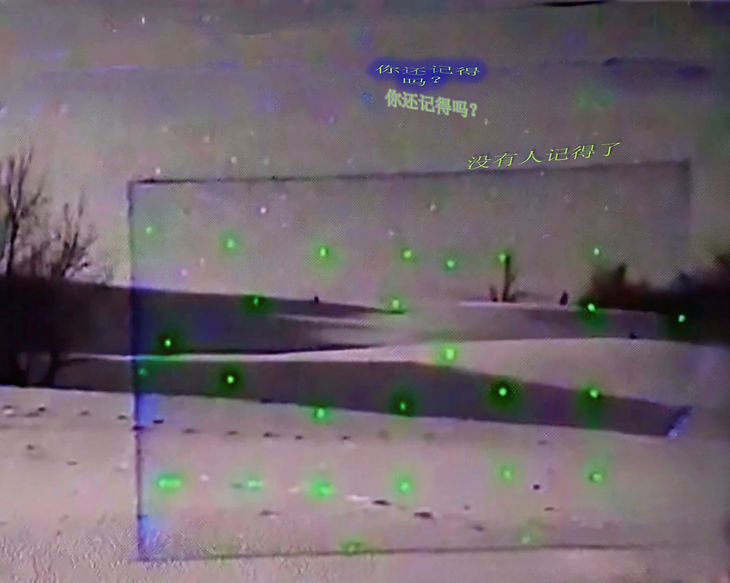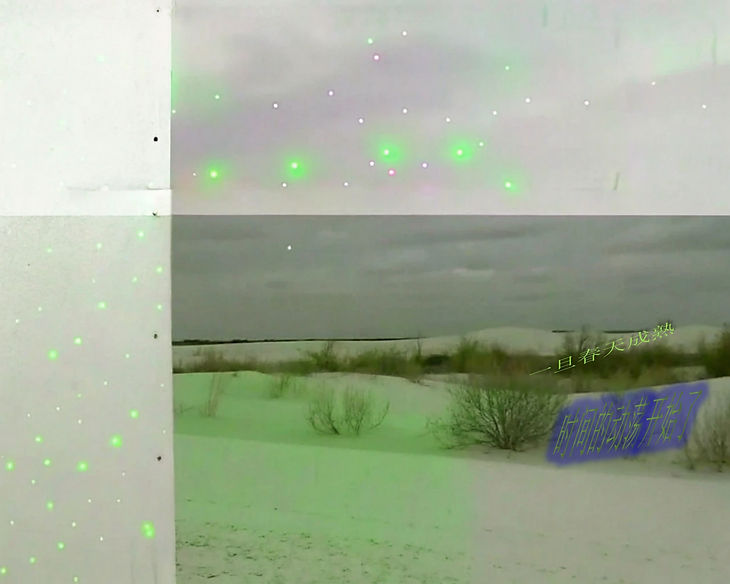Gobi-hauntology phase I
2025
inkjet prints, sound
If bounding boxes in AI systems and computer vision are used to distinguish signal from noise, I hope to frame the mysterious connections among the invisible, ghosts, plants and weather patterns, moments of magic, and moments of trauma. Such ambiguity and multiplicity of meaning stand in opposition to the “clarity” and “single interpretation” of data. I have juxtaposed marker boxes of various appearances; they become part of a shamanic ritual, revealing phantom layers and fragments.
At the same time, these visual noises and interference textures act as optical camouflage that renders the images illegible to AI algorithms, resisting classification and analytical logic. They embody the “spirits” and phantoms. To me, all artifacts in digital systems unveil phantom layers, carrying the energy of memory. Interestingly, in Chinese, “artifacts” is translated as 伪影, evoking a haunted state.
The images, texts, and sound in this project borrow from the aesthetic of weirdcore/dreamcore memes. The sound is a re-enactment of the music from the “Weather Forecast” program, embedding nostalgic familiarity with uncanny dissonance.
This project stems from my longstanding fascination with weirdcore/dreamcore memes. These low-quality images, often retro-styled, carry an eerie atmosphere with text and music. They are usually associated with nostalgia—depicting warm scenes that nonetheless harbor an underlying threat, evoking both unease and a paradoxical comfort. I observed a similarity between the use of symbols in this aesthetic and the visual language of military and surveillance imagery. For example, marker boxes, commonly used to identify potential threats or unseen entities, embody both technological logic and a subtle directive toward hidden relationships and meanings.
Such images are what Harun Farocki calls “operational images”, tools for intervention rather than mere representation. They are used to carry out specific tasks—such as target localization, navigation, and strategic planning. While Jussi Parikka views operational images as an energy transformation of geological materials, this project attempts to present alternative energetic states.
The project is closely connected to my recent years of living and conducting research in Gobi. The region’s unique ecology coexists with infrastructure like satellite bases. The desert is not empty but a theater of signals and noise. With the deployment of satellite systems, herders have started using satellite positioning and navigation for grazing, and the remote borderlands of the desert seem increasingly integrated into a virtual system. This shift is altering people’s perceptions of space and ecology. However, while living there, I experienced moments of magic that felt almost animistic. I also met a shaman, which led me to reflect on what alternative forms of perception tied to a shamanic perspective might look like.

“Unknown Unknown Unknown
The night stops growing
Stars chase each other”

“What if never leaving”

“I come from the edge of the world
I come from the heart of the wind
I have seen terrible things
Even cannot sing them”

“I'm flying!
I'm flying!
I'm flying!
Nothing can hold me anymore!”

“Never forget that evening
You said: Am I in your dream?
In many image layers”

“The roar of light deafens the ears
The brightness of light blinds the eyes
The desert ground rumbles
Unable to bear the face of light”

“Why do you hurt me
Why do you hurt me
I'm sorry
I'm sorry
Where did you go”


“It's time to go home
Wait, time is broken”

“Do you remember?
Do you remember?
No one remembers anymore”

“It's singing!
It's singing for us!”

“Once the moon appears repeatedly
The desert will no longer be safe”

“Old dream and even older dream”

“Once spring ripens
The turbulence of time begins”